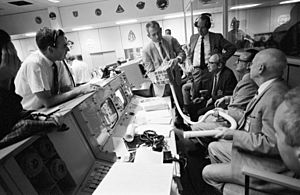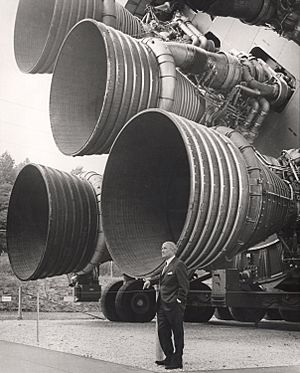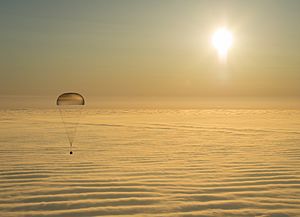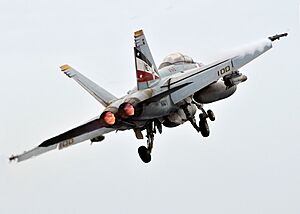Aerospace engineering facts for kids

|
|
| Occupation | |
|---|---|
| Names | Aerospace engineer |
| Profession | |
|
Activity sectors
|
Aeronautics, astronautics, science |
| Description | |
| Competencies | Technical knowledge, analytical skills, management skills (see also glossary of aerospace engineering) |
|
Education required
|
Bachelor's degree |
|
Fields of
employment |
Technology, science, space exploration, military |
Aerospace engineering is a cool field of engineering. It's all about designing and building amazing machines that fly, both in Earth's atmosphere and in outer space. This includes things like airplanes, helicopters, rockets, and satellites!
There are two main parts to aerospace engineering:
- Aeronautical engineering: This focuses on vehicles that fly inside Earth's atmosphere, like airplanes.
- Astronautical engineering: This deals with vehicles that travel in space, like spacecraft and rockets.
Sometimes, people call astronautical engineering "rocket science." It's a big job that needs a lot of smarts!
Contents
What is Aerospace Engineering?
Flying machines face tough conditions. Think about how air pressure and temperature change high up in the sky or in space. These machines also have to handle strong forces. Because of this, aerospace engineers use many different skills.
They combine knowledge from areas like:
- Aerodynamics: How air moves around objects.
- Air propulsion: How to make vehicles move forward.
- Avionics: The electronic systems in aircraft and spacecraft.
- Materials science: Choosing the right materials for strength and lightness.
- Structural analysis: Making sure the parts are strong enough.
- Manufacturing: How to build these complex machines.
Putting all these parts together is what aerospace engineering is about. Since it's so complex, teams of engineers work together. Each engineer is an expert in their own special area.
History of Flight and Space Travel
The idea of flying machines goes way back. But the real start of aerospace engineering was in the late 1800s and early 1900s. Sir George Cayley was a very important person in early flight. He was one of the first to understand the forces of lift (what makes things go up) and drag (what pulls them back).
Early flight knowledge came from trying things out and learning from other types of engineering. Scientists in the 1700s already understood some things about how fluids move.
In December 1903, the Wright Brothers made history. They flew the first powered airplane that could be controlled. Their flight lasted 12 seconds! After that, during World War I, airplane design improved a lot.
World War I and Beyond
In 1914, Robert Goddard got patents for rockets. His ideas included using different kinds of fuel and building rockets in stages. This was a big step for future space travel.
On March 3, 1915, the U.S. government created the National Advisory Committee for Aeronautics (NACA). This was the first group to support aviation research. Later, NACA opened its first research lab in 1920.
Between World War I and World War II, flying became more common for regular people. Famous planes from this time include the Curtiss JN 4 and the Fokker Trimotor. Military planes also advanced, like the Supermarine Spitfire. A huge step was the first working Jet engine-powered plane, the Messerschmitt Me 262, which flew in 1944.
The term "aerospace engineering" was first used in 1958. It combined "aero" (for air) and "space" (for outer space). This showed that engineers were now working on both airplanes and spacecraft.
The Space Race and Modern Aviation
The Cold War brought a race to space. On October 4, 1957, the USSR launched Sputnik, the first satellite. In response, U.S. aerospace engineers launched Explorer I, America's first satellite, on January 31, 1958.
The National Aeronautics and Space Administration was founded in 1958. In 1969, Apollo 11 made history. It was the first time humans landed on the Moon. Neil Armstrong and Buzz Aldrin walked on the Moon, while Michael Collins orbited above.
On January 30, 1970, the Boeing 747 made its first commercial flight. This huge plane became known as the "Jumbo Jet." It could carry up to 480 passengers!
In 1976, the Concorde took flight. It was the first passenger plane that could fly faster than the speed of sound (supersonic). France and Britain worked together to build it.
On December 21, 1988, the Antonov An-225 Mriya cargo plane flew for the first time. It's still the heaviest aircraft ever built and can carry the biggest and longest cargo.
The Airbus A380 had its first commercial flight in 2007. This plane was designed to carry even more passengers than the Boeing 747, up to 853 people!
What Aerospace Engineers Study


Aerospace engineers learn about many different things to design and build aircraft and spacecraft. Here are some key areas:
- Radar Cross-Section: How visible a vehicle is to radar.
- Fluid Mechanics: How liquids and gases (like air) flow around objects. This includes aerodynamics, which is about how air moves over wings.
- Astrodynamics: The study of how things move in space, like satellites in orbit.
- Statics and Dynamics: The study of forces, movement, and balance in mechanical systems.
- Mathematics: Very important! This includes calculus, differential equations, and linear algebra.
- Electrotechnology: The study of electronics used in engineering.
- Propulsion: How to make a vehicle move. This involves jet engines, rockets, and even newer ideas like electric propulsion.
- Control Engineering: Designing systems to make sure aircraft and spacecraft fly smoothly and stay stable.
- Aircraft Structures: Designing the physical parts of the craft so they can handle the forces of flight. Engineers try to make them light, strong, and affordable.
- Materials Science: Studying the best materials to build aerospace structures. New materials are often invented or improved for specific needs.
- Solid Mechanics: Looking at how stress and strain affect the parts of a vehicle.
- Aeroelasticity: How air forces and the flexibility of a structure interact. This can cause problems like "flutter" if not designed well.
- Avionics: Designing and programming the computer systems inside aircraft and spacecraft.
- Software: Creating the computer programs that control everything from flight to ground operations.
- Risk and Reliability: Figuring out how likely something is to fail and making sure systems are safe.
- Noise Control: Understanding how sound travels and how to reduce noise from aircraft.
- Aeroacoustics: The study of noise created by air moving or by air forces on surfaces.
- Flight Testing: Flying new aircraft to test their performance and make sure they meet design goals.
Many of these topics are based on physics. For example, fluid dynamics helps with aerodynamics. Engineers also do a lot of testing. In the past, they used small models in wind tunnels. Now, computers can simulate how fluids behave, which saves time and money.
Aerospace engineering also involves putting all the different parts of a vehicle together. This includes power systems, communication, temperature control, and even life support systems for spacecraft. They also consider the entire life of the vehicle, from design to how long it will last.
How to Become an Aerospace Engineer
You can study aerospace engineering at many universities. You can get different degrees, like a bachelor's, master's, or Ph.D. Some schools might focus more on aeronautical (airplanes) or astronautical (spacecraft) engineering.
If you want to be an aerospace engineer, it's good to be strong in:
- Chemistry
- Physics
- Computer science
- Mathematics
"Rocket Scientist" in Pop Culture
The phrase "rocket scientist" is often used to describe someone super smart. People say "It's not rocket science" to mean something is easy.
But actually, "science" is about understanding how the universe works. "Engineering" is about using that understanding to solve problems and create new technology. So, a more correct term would be "rocket engineer"! But people often use "science" and "engineering" as if they mean the same thing.
See Also
 In Spanish: Ingeniería aeroespacial para niños
In Spanish: Ingeniería aeroespacial para niños
- American Institute of Aeronautics and Astronautics
- American Helicopter Society International
- Flight test
- Glossary of aerospace engineering
- Index of aerospace engineering articles
- List of aerospace engineering schools
- List of aerospace engineers
- List of Russian aerospace engineers
- Sigma Gamma Tau – aerospace engineering honor society
- Space Power Facility
- Outline of rocketry




